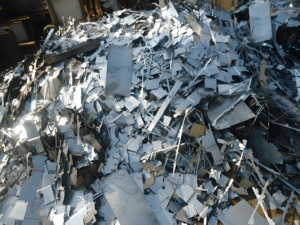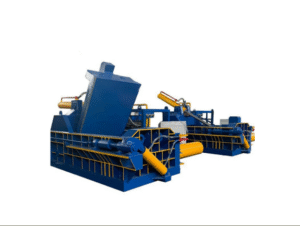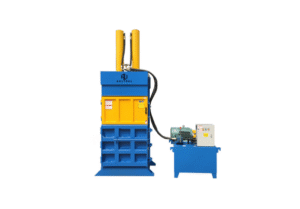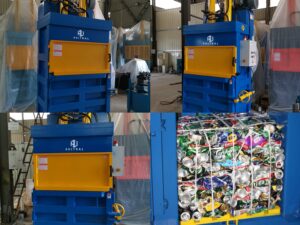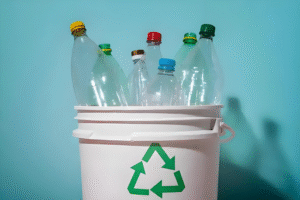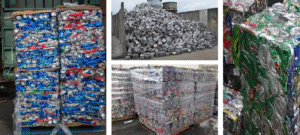Introduction
In today’s recycling and waste management industry, balers have become indispensable equipment for processing various materials efficiently. As environmental concerns and energy efficiency gain prominence, the choice between hydraulic and electric balers has become increasingly important for businesses looking to optimize their operations. This comprehensive analysis examines the energy consumption patterns, operational characteristics, and ideal application scenarios for both hydraulic and electric balers, providing valuable insights for decision-makers in the recycling sector.
Understanding the Technologies
Hydraulic Balers
Hydraulic balers utilize pressurized fluid systems to generate the tremendous force required for compacting materials. These systems consist of:
-
Hydraulic pumps (typically powered by electric motors or diesel engines)
-
Hydraulic cylinders
-
Control valves
-
Fluid reservoirs
-
Extensive network of hoses and fittings
The hydraulic fluid (usually oil) transmits power from the pump to the cylinders, creating the compressive force needed for baling. These systems are renowned for their ability to generate extremely high pressures, often reaching hundreds of tons of force.
Electric Balers
Electric balers employ direct mechanical compression systems powered by electric motors. These systems typically feature:
-
High-torque electric motors
-
Mechanical linkage systems (screws, gears, or cranks)
-
Electronic control systems
-
Fewer moving parts compared to hydraulic systems
The electric motor directly drives the compression mechanism, eliminating the need for hydraulic fluid and the associated components. This design offers a more straightforward power transmission path from the energy source to the compression mechanism.
Energy Consumption Comparison
Power Requirements
Hydraulic balers generally require:
-
Higher peak power demands during compression cycles
-
Continuous power to maintain hydraulic pressure
-
Additional energy for cooling hydraulic fluid
-
Power losses in hydraulic transmission (typically 15-25%)
Electric balers typically demonstrate:
-
More consistent power demand throughout operation
-
Higher energy efficiency in power transmission (85-95%)
-
No energy loss through fluid systems
-
Lower standby power consumption
Operational Energy Use
Detailed energy consumption analysis reveals significant differences:
Hydraulic System Energy Flow:
-
Electrical energy powers the motor (100%)
-
Motor drives hydraulic pump (90-95% efficiency)
-
Hydraulic system transmission (75-85% efficiency)
-
Actual work performed at cylinder (60-80% of initial energy)
Electric System Energy Flow:
-
Electrical energy powers the motor (100%)
-
Mechanical transmission to compression mechanism (90-98% efficiency)
-
Actual work performed (85-95% of initial energy)
Energy Efficiency Metrics
Comparative studies show:
-
Hydraulic balers average 60-75% overall system efficiency
-
Electric balers achieve 80-92% overall system efficiency
-
Energy savings with electric models typically range from 15-40%
-
Hydraulic systems show better efficiency at very high pressures (>200 tons)
Cost Implications
Initial Investment
Hydraulic balers generally have:
-
Lower upfront costs for small to medium capacity models
-
More expensive maintenance requirements over time
-
Higher costs for high-capacity industrial models
Electric balers typically feature:
-
Higher initial purchase prices
-
Lower long-term maintenance costs
-
More competitive pricing for mid-range capacities
Operational Costs
Energy cost analysis demonstrates:
-
Electric balers save $500-$2,000 annually in energy costs (depending on usage)
-
Hydraulic systems incur additional costs for:
-
Hydraulic fluid replacement ($200-$800 annually)
-
Filter changes ($100-$300 annually)
-
Potential leak repairs
-
-
Electric models have fewer wear components, reducing maintenance expenses
Total Cost of Ownership
Five-year cost projections show:
-
Small operations (1-5 tons/day): Electric balers often more economical
-
Medium operations (5-20 tons/day): Comparable total costs
-
Large operations (20+ tons/day): Hydraulic may be more cost-effective
Performance Characteristics
Compression Capabilities
Hydraulic balers excel in:
-
Achieving extremely high pressures (up to 300+ tons)
-
Handling tough, dense materials (metal scraps, dense plastics)
-
Maintaining consistent pressure throughout stroke
Electric balers perform best in:
-
Medium-pressure applications (up to 150 tons)
-
Consistent, repetitive baling operations
-
Applications requiring precise control
Speed and Cycle Times
Operational speed comparison:
-
Hydraulic systems typically have faster cycle times (20-30 seconds)
-
Electric models may require slightly longer cycles (30-45 seconds)
-
Hydraulic systems recover faster between cycles
Noise Levels
Environmental impact differences:
-
Hydraulic systems operate at 75-85 dB
-
Electric models typically at 65-75 dB
-
Electric balers better suited for noise-sensitive environments
Maintenance Requirements
Hydraulic System Maintenance
Regular maintenance includes:
-
Frequent fluid checks and changes (every 1,000-2,000 hours)
-
Filter replacements (every 500-1,000 hours)
-
Hose and seal inspections
-
Potential for fluid leaks requiring cleanup
Electric System Maintenance
Primary maintenance needs:
-
Motor bearing lubrication (annually or bi-annually)
-
Mechanical linkage inspection
-
Electrical component checks
-
Generally simpler and less frequent
Application Scenarios
Ideal Uses for Hydraulic Balers
Best suited for:
-
Heavy-duty industrial applications
-
Automotive scrap processing
-
Dense metal recycling
-
Industrial waste compaction
-
-
High-volume recycling centers
-
Municipal waste facilities
-
Large-scale paper/cardboard operations
-
-
Applications requiring extreme pressure
-
Compacting difficult materials
-
Processing mixed waste streams
-
Optimal Applications for Electric Balers
Most advantageous for:
-
Small to medium recycling operations
-
Retail back-of-store compaction
-
Office paper recycling
-
Small manufacturing facilities
-
-
Environmentally sensitive locations
-
Indoor facilities
-
Urban recycling centers
-
Noise-restricted areas
-
-
Operations prioritizing clean maintenance
-
Food processing facilities
-
Pharmaceutical waste
-
Clean manufacturing environments
-
Environmental Considerations
Energy Efficiency Impact
Carbon footprint analysis:
-
Electric balers reduce CO2 emissions by 15-30%
-
Lower energy consumption supports sustainability goals
-
Better alignment with green certifications
Material Handling
Environmental advantages:
-
Hydraulic systems risk fluid contamination
-
Electric systems eliminate hydraulic fluid disposal
-
Both systems facilitate recycling efforts
Future Developments
Technological Advancements
Emerging innovations:
-
Smart hydraulic systems with efficiency optimization
-
High-torque direct-drive electric motors
-
Hybrid systems combining both technologies
-
AI-powered energy management systems
Market Trends
Industry shifts:
-
Growing preference for electric models in medium-duty applications
-
Continued dominance of hydraulic in heavy industrial uses
-
Increasing regulations favoring energy-efficient equipment
Conclusion
The choice between hydraulic and electric balers depends on multiple factors including operational scale, material types, budget considerations, and environmental priorities. While hydraulic systems remain the go-to solution for heavy-duty, high-pressure applications, electric balers offer compelling advantages in energy efficiency, maintenance simplicity, and environmental impact for many operations.
Businesses should carefully evaluate their specific needs, considering:
-
Daily throughput requirements
-
Material characteristics
-
Available power infrastructure
-
Long-term operational costs
-
Sustainability objectives
As technology continues to evolve, the gap between these two systems may narrow, with potential hybrid solutions offering the best of both worlds. For now, understanding these fundamental differences enables recycling operations to make informed decisions that balance performance, efficiency, and cost-effectiveness.

